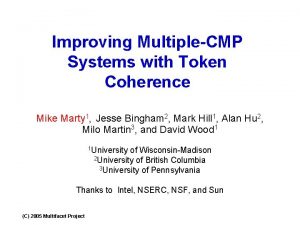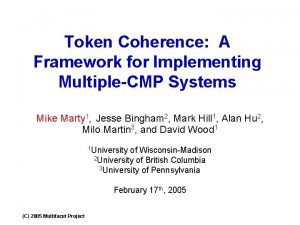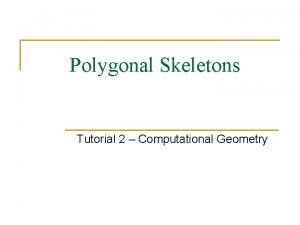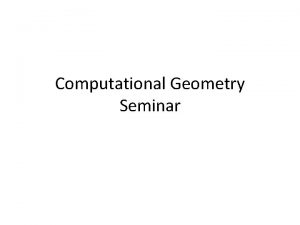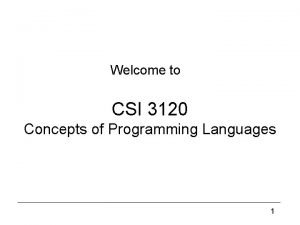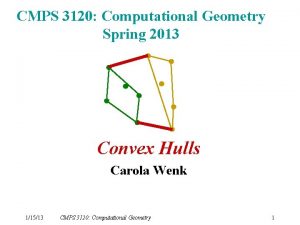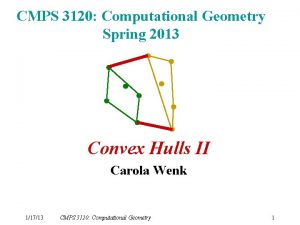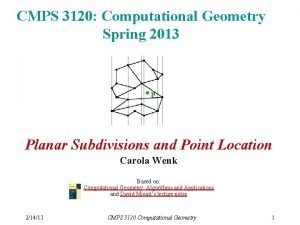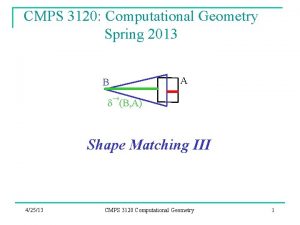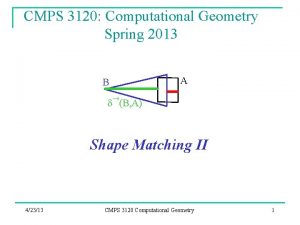CMPS 3120 Computational Geometry Spring 2013 Expected Runtimes






- Slides: 6

CMPS 3120: Computational Geometry Spring 2013 Expected Runtimes Carola Wenk 2/14/13 CMPS 3120 Computational Geometry 1

Probability • • • Let S be a sample space of possible outcomes. E S is an event The (Laplacian) probability of E is defined as P(E)=|E|/|S| P(s)=1/|S| for all s S Note: This is a special case of a probability distribution. In general P(s) can be quite arbitrary. For a loaded die the probabilities could be for example P(6)=1/2 and P(1)=P(2)=P(3)=P(4)=P(5)=1/10. Example: Rolling a (six-sided) die • S = {1, 2, 3, 4, 5, 6} • P(2) = P({2}) = 1/|S| = 1/6 • Let E = {2, 6} P(E) = 2/6 = 1/3 = P(rolling a 2 or a 6) In general: For any s S and any E S • 0 P(s) 1 • P(s) = 1 s S • P(E) = P(s) s E 2/14/13 CMPS 3120 Computational Geometry 2

Random Variable • A random variable X on S is a function from S to R X: S → R Example 1: Flip coin three times. • S = {HHH, HHT, HTH, HTT, THH, THT, TTH, TTT} • Let X(s) = # heads in s X(HHH) = 3 X(HHT)=X(HTH)=X(THH) = 2 X(TTH)=X(THT)=X(HTH) = 1 X(TTT) = 0 Tail Head Example 2: Play game: Win $5 when getting HHH, pay $1 otherwise • Let Y(s) be the win/loss for the outcome s Y(HHH) = 5 Y(HHT) = Y(HTH) = … = -1 What is the average win/loss? 2/14/13 CMPS 3120 Computational Geometry 3

Expected Value • The expected value of a random variable X: S→R is defined as E(X) = P(s) X(s) = P({X=x}) x Notice the similarity to the s S x R arithmetic mean (or average). Example 2 (continued): • E(Y) = P(s) Y(s) = P(HHH) 5 + P(s) (-1) = 1/23 5 + 7 1/23 (-1) s S{HHH} = (5 -7)/23 = -2/8 = -1/4 = P({Y=y}) y = P(HHH) 5 + P(HHT) (-1) + P(HTH) (-1) + P(HTT) x R (-1) + P(THH) (-1) + P(THT) (-1) + P(TTH) (-1) + P(TTT) (-1) The average win/loss is E(Y) = -1/4 Theorem (Linearity of Expectation): Let X, Y be two random variables on S. Then the following holds: E(X+Y) = E(X) + E(Y) Proof: E(X+Y) = P(s) (X(s)+Y(s)) = P(s) X(s) + P(s) Y(s) = E(X) + E(Y) s S 2/14/13 s S CMPS 3120 Computational Geometry 4

Randomized algorithms • • • Allow random choices during the algorithm Sample space S = {all sequences of random choices} The runtime T: S→R is a random variable. The runtime T(s) depends on the particular sequence s of random choices. Consider the expected runtime E(T) Example 3 (Quicksort): • Pick a random pivot to partition the array around. • Runtime depends on random pivot choices. • Best case: ½ split in each step. (In fact, 1/10 : 9/10 would work as well. ) O(n log n) runtime • Worst case: 0 : (n-1) split O(n 2) runtime • Expected runtime E(T) “averages” over all possible splits, and one can show that E(T) = O(n log n) 2/14/13 CMPS 3120 Computational Geometry 5

Randomized algorithms Example 4 (Trapezoidal map): • The runtime depends on the order in which trapezoids are inserted: n – ki = # new trapezoids created; total runtime is i=1 ki n – Worst case: ki=O(i) Total worst-case runtime is i=1 i = O(n 2) – Best case: ki=O(1) Total best-case runtime is i=1 n 1 = O(n) • Insert segments in random order: – P = {all possible permutations/orders of segments}; |P| = n! for n segments – ki = ki(p) for some random order p P – E(ki) = O(1) (see theorem on slides) n n n – Expected runtime E(T) = E( i=1 ki) = i=1 E(ki) = O( i=1 1) = O(n) linearity of expectation 2/14/13 CMPS 3120 Computational Geometry 6

